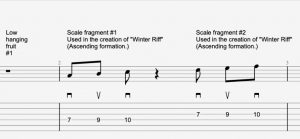Reverse Engineering Inspiration – How to Beat Writer’s Block in 4 Steps
Writer’s block can rear it’s ugly mug in more ways than one but in my observations as both a songwriter and songwriting coach, a commonality I always seem to find is a lack of taking action as the main culprit.
This is a guest post written by guitarist & vocalist Aaron Cloutier.
The age old myth is that you always have to “wait for inspiration to strike” in order for new musical/lyrical ideas to surface.
In doing so, you’re then motivated to take action.
Sound familiar?
While there’s no denying that inspiration CAN indeed strike at any given moment, the truth is that we can also take conscious steps to create our own inspired moments. (It’s true!)
Think of it like this. If you’re the type that tends to follow this mindset:
Inspiration leads to motivation which then leads to action.
Try turning this way of thinking on its head and do the exact opposite!
Taking action leads to motivation which leads to inspiration.
To test this way of thinking out, let’s take a look at a study I did on myself where I reverse engineered a rough musical idea I came up with to see everything that went it to it. By doing so, my aim was to collect all the data in an effort to replicate results (albeit in a different way as results may vary) in a conscious way.
Let’s dig in.
Songwriter’s log Friday, January 8th, 2025.
Today, I stumbled on to a very rough idea while fumbling around on my guitar.
For this riff, I didn’t consciously plan on writing anything. I was just noodling on the guitar while listening to a drone as I was finally getting sun on my face mid day.
One thing led to another however and the end result was this rough idea which I’m
quite fond of.
I’ve been on a kick of transcribing every new idea I come up with lately. It’s a skill I’ve been trying to develop over time to improve as a teacher as well as a writer and overall musician.
Because of this, I found myself asking the following question.
“All that happened really quickly! What were all of the elements that contributed to me being able to facilitate this new musical idea into existence? What were all the components that allowed me to take what was in my head and get it recorded, and now transcribed just the way I heard it upon inspiration?”
I decided to write it all down and share it with you. May these steps serve as a road map to get you out of the mud if you get stuck.
Analyzing a rough idea. “How’d I do that?!”
Step 1:
Inspiration.
Though I wasn’t consciously trying to write music while out on my porch, I was listening to the Brain.fm app while out there and in particular, a drone called “Coherent States” that is scientifically designed to trigger more creative states of mind. You don’t need the app to achieve this state of course but I certainly find it helpful.
Other ways to generate this state of mind that have worked for me include taking walks in nature, listening to binaural beats and meditation. Honestly though, boredom is a huge proponent and even mundane tasks like sweeping the floor, doing the dishes, cleaning the bathroom can all cause the mind to “rebel” and come up with creative solutions to entertain itself while being subjected to said boredom. At any rate,creating time and space for these activities to occur is essential in my opinion.
Step 2:
Capturing the idea – Taking stock of your tools.
These are my go to techniques and “materials” I use when creating simple ideas because they’re so ingrained in my nervous system that I know they’ll show up when I’m in the heat of the moment trying to catch hold of a cool idea before I forget it. In this state, I’m not concerned with technical perfection. I’m just trying to nail down the idea. Here are some of the “tools” I use to quickly get the job done. For
the sake of this writing, I’ve labeled them as “low hanging fruit.”
Low hanging fruit for me:
#1 Using two fragments of a three note per string scale shape in A minor which are very familiar to my hands.
Each fragment consists of a three note sequence that stretches across one string (in this case, it would be the “D” and “G” strings respectively. As I mentioned before, these patterns feel very comfortable under my fingers so it’s something I tend to gravitate towards just by muscle memory alone when I’m mindlessly noodling and leads to new ideas. (See picture below.)
#2 Pedal point. I always love the sound of a droning root note when comparing other notes in the scale to it. It allows me to explore the nature of the scale and explore a wide variety of note combinations. Using the scale fragment in Am in conjunction with playing an open “A” string.
#3 Down picking. It’s reliable and accurate. In this particular case, I’m not trying to be flashy or build on my elementary level hybrid picking technique while trying to get my ideas out. All I need is something steady that I can count on to execute the idea with as much precision as possible to match what I hear in my head.
(Here’s a picture to show #2 and #3 together in action.)
#4 Figure out a tempo.
This one should be straightforward enough for most of you but for the sake of being thorough, here’s how I go about finding the right tempo.
After capturing the rough idea in my phone, I’ll listen back and tap my foot to the general rhythm of things and try my best to lock that into my body. From there, I’ll grab a metronome and tap the tempo of what feels right and refine if necessary.
Simple!
After spending a couple minutes getting the right feel of the idea, I deduced that the riff fit best at a tempo of 67 bpm.
#5 Figure out the rhythm.
Because I was going by feel, apparently my body was feeling pretty even that day ha ha so for this example, things are in a nice straightforward 4/4 meter.
Step 3:
Capture your idea.
When getting the raw inspiration trapped here on in the physical realm, things don’t have to be anywhere near perfect or polished. Any kind of recording device will do in this instance. Obviously, the phone is a no-brainer when nailing down rough ideas.
From there, I used two different methods of developing the rough idea. Namely guitar pro 8 and Logic Pro x.
First, I transcribed the guitar riff by hand in guitar pro 8 making sure to include the rhythm and tempo information as I will need that shortly.
Then, I exported the guitar parts as a MIDI file which I then imported into Logic Pro X.
Here’s a quick video to demonstrate the process:
In doing so, I’ve created a session containing not only my guitar information as MIDI but also the time signature and tempo information so I can can quickly create a rhythm section to support my melodic idea inside of Logic.
Step 4:
Expand on your idea.
Taking what I know of the riff idea, I have plenty of information to begin exploring how to create parts that complement this riff.
Here’s all the information associated with this riff Idea.
Key – A Minor
Notes found in the A minor scale: A – B – C – D – E – F – G – A
Tempo: 67 bpm
Meter: 4/4
Chords available:
Am – Bº – C – Dm – Em – F – G
Chords in the riff:
C maj 7/B
Now let’s create from scratch.
The next question I asked myself is “Can I do this again but consciously?” Which I already knew was yes. The fact that I’ve been able to reverse engineer the subconscious process that goes into writing this riff, I can now use this information as a “blueprint” of sorts to come up with something new.
Absolutely! Other questions that came up were “Will I achieve the same results by deliberately following this blueprint?”
The truth is that the outcome itself doesn’t matter and should not be your focus when beginning to consciously taking action to spark some creativity. There’s a time to be more critical but that comes later. In the meantime, I offer this “blueprint” to you as a means of getting started. A set of limitations to paint you into a corner that you have break out of creatively. Creative problem solving as it were. That’s literally what this is! So much of creativity is based on simply taking action. Once you do, a certain mojo kicks in. It may take a little time and it may take a little patience but if you let go of the need to achieve a specific outcome, get started and allow yourself to go wherever the idea wants you to, I promise that you’ll walk away from the experience being surprised at what came out.
Remember, instead of thinking inspiration – motivation – action, think action – motivation – inspiration.
Here’s a step by step songwriting exercise I do with my private clients.
Let’s say you want to create something out of thin air. We’ll keep it simple right now. Let’s say it’s a melody. Let’s use the exact same information listed above.
Musical Parameters:
Key – A minor
Notes found in the A minor scale: A – B – C – D – E – F – G – A
Tempo: 67 bpm
Meter: 4/4
Techniques:
Choose one from the list below that feels the most natural to you. (Or add your own.)
Down picking, alternate picking, hybrid picking, finger picking, tapping, slapping etc.
Concepts:
Pedal Point
Great! Here’s the assignment. ––
-Pick up to 4 notes (octaves included!)
-Set your metronome to 67 bpm.
-Set a timer for five minutes.
Your mission should you choose to accept it is to explore different combinations of your chosen four notes as they play off a constant pedaling root note of “A.”
Keep in mind, all we’re doing here is playing. Keep it light, keep loose and stay open, easy and curious.
Have fun and thanks for reading.
Let me know if you do the exercise and what you come up with!
-Aaron



